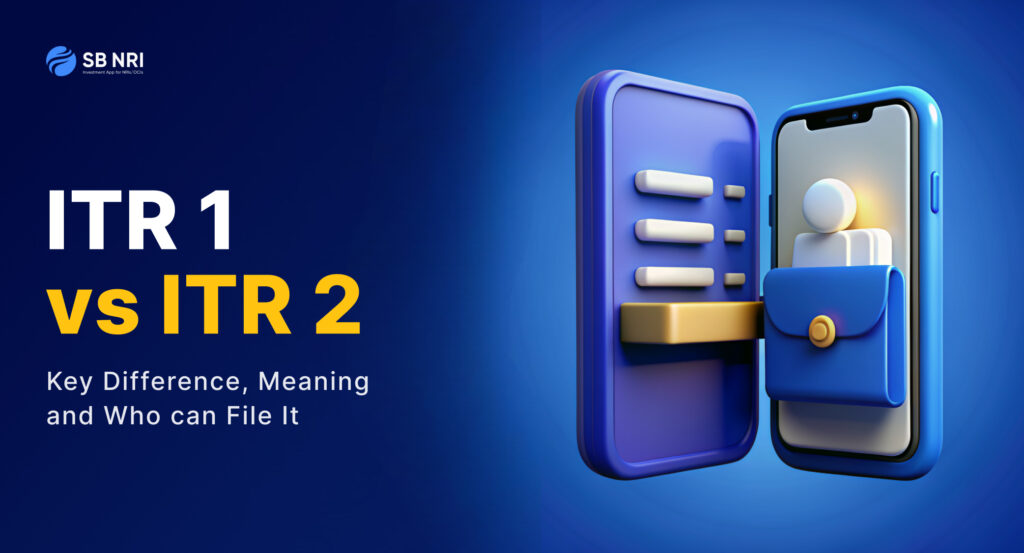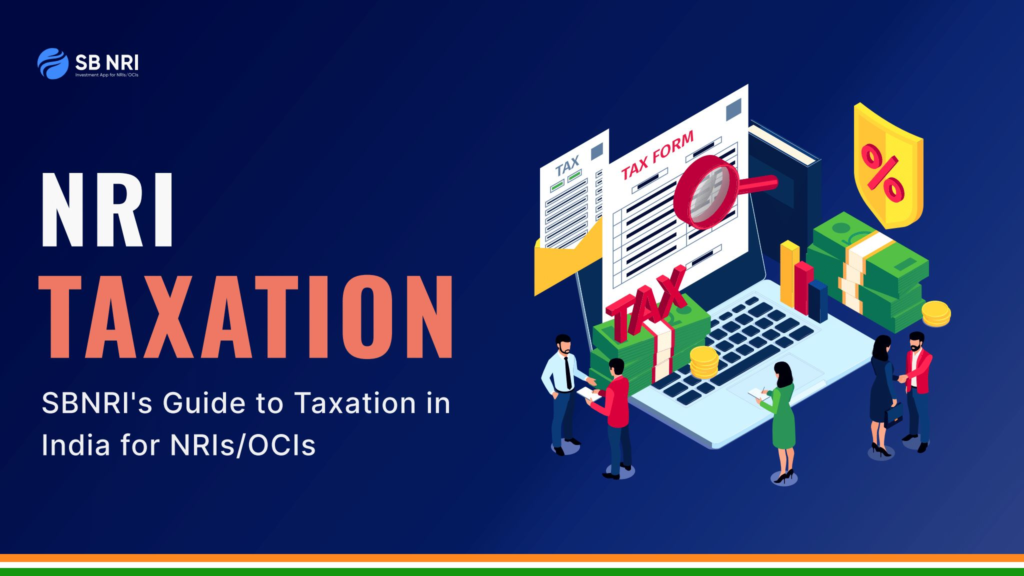
Understanding ITR-1 and ITR-2 is important for accurate tax filing and compliance, it makes sure that you fill in the documents that align with your eligibility. A lot of Non-Resident Indians(NRIs) and Overseas Citizens of India (OCIs) often get confused about whether they can file ITR 1 or not. ITR-1 (Sahaj) simplifies tax returns for resident individuals with straightforward incomes up to ₹50 lakh from sources like salary and interest. In contrast, ITR-2 talks about more complex income scenarios, such as multiple properties, capital gains, and foreign assets, making it essential for higher-income individuals, NRIs/OCIs, and those with diverse income sources. Knowing which form to use ensures proper tax management and avoids legal complications. Find all you need to know about ITR 1 vs ITR 2, its key differences, and which one to file as a taxpayer.
What is ITR 1?
ITR-1, also known as Sahaj, is a simplified income tax return form for resident individuals in India whose total income does not exceed ₹50 lakh in a financial year. ITR 1 means a form that covers income from salary, one house property, family pension, agricultural income (up to ₹5000), and other sources like interest from savings accounts and deposits. This form can also include the clubbed income of a spouse or minor, provided the income sources fall within the specified limits. It is designed for easy filing of straightforward income scenarios.
Also read: Can NRIs file ITR 1 in India? Types of ITR forms for NRIs
What is ITR 2?
ITR-2 is an income tax return form for individuals, Hindu Undivided Families (HUFs), NRIs, OCIs not having income from business or profession. It includes income from salary, multiple house properties, capital gains, winnings from lotteries, and foreign income. It covers agricultural income over ₹5000 and income from virtual digital assets like cryptocurrency. This form is also for residents with foreign tax credits, directors of companies, and those with unlisted equity shares. It’s suitable for higher incomes exceeding ₹50 lakh from diverse sources.
Also read: ITR Filing for NRIs AY 2024-25: Step-by-Step ITR Filing Process

What is ITR 2A?
The ITR-2A is a newly introduced income tax return form by the Income Tax Department, for individuals and Hindu Undivided Families (HUFs) who earn a salary, own multiple house properties, and do not have income from capital gains. You can fill ITR-2A form under the following criteria:
- You should be a salary or a pension-earning person.
- You should be earning income from more than one property.
- You should be earning income from other sources, excluding lotteries, gambling, and racehorses.
You should avoid filling ITR-2A in the following circumstances:
- If you have any income from capital gain.
- If you enjoy tax benefits for taxes paid in foreign countries.
- If you have a source of foreign income.
- If your income is generated from a business or profession.
- If you own financial interests or assets outside India.
Also read: 5 Tips for NRIs Filing Income Tax Returns in India
ITR 1 vs ITR 2: Key Differences
| CRITERIA | ITR-1 | ITR-2 |
| Eligibility | Resident individuals with total income up to ₹50 lakh | Individuals, HUFs, NRIs, OCIs with income from sources other than business or profession; total income can exceed ₹50 lakh |
| Income from house property | One house property | Multiple house property |
| Capital gain | No | Yes (Short-term and long-term) |
| Other income sources | Interest from savings accounts, deposits, income tax refunds, enhanced compensation, and any other interest income, family pension | Interest income, winning from lottery, racehorses, other legal gambling. |
| Agriculture Income | Upto 5000 | Above 5000 |
| Foreign income/assets | No | Yes |
| Income from Virtual Digital assets | No | Yes |
| Tax deduction under section 194N | No | Yes |
| Number of house property | One | More than one |
| Residential status | Residential individual | Residents, Resident Not Ordinarily Resident (RNOR), and Non-Resident |
| Income clubbing | Income of spouse (not under Portuguese Civil Code) or minor if within specified limits | Not specifically for clubbed income, but covers broader income sources and scenarios |
| Lottery/Racehorses/Gambling | No | Yes |
| Applicable for RNOR and NRI | No | Yes |
Who is eligible to fill ITR-1?
ITR 1 SAHAJ Form is not for Non-ordinary residents, or for an individual who is either a Director in a company or has invested in Unlisted Equity Shares. ITR 1 Form is filed by:
- Taxpayers
- individuals who are a Resident with a total Income of up to INR 50 lakhs when the Income is from Salaries, One House Property, Other Sources (Interest, dividend, etc.)
- Agricultural Income up to INR 5 thousand.
Also read: Getting ITR Notice as NRI/OCI? Here’s what you need to know
Who is eligible to fill ITR-2?
Individuals with income from the given sources are eligible to fill out the ITR 2 form:
- Income from salary/pension.
- Income from house property or income can be from more than one house property.
- Income from capital gains/loss on sale of investments/property included both short-term and long-term.
- Income from other sources, including winning from lottery, bets on racehorses, and other legal means of gambling.
- Foreign income, claiming foreign tax credit and disclosing the foreign assets of the Residents.
- Agricultural income of more than Rs 5,000.
- Resident not ordinarily resident and a non-resident.
- Income from Virtual Digital Assets like Crypto currency.
Also Read: Income Tax e-filing: Top 10 NRI Income Tax Filing Benefits

Types of ITR forms for NRIs for filing returns
NRIs have specific guidelines to follow when filing their income tax returns in India. There are two options as ITR forms for NRIs when filing returns. The choice of the ITR form depends on the sources and amount of their income. Here’s a detailed look at the appropriate forms for NRIs:
- ITR 2: This form is suitable for NRIs who do not have income from a business or profession in India. It covers income from salary, house property, capital gains, and other sources, making it the appropriate choice for most NRIs.
- ITR 3: NRIs having income from a business or profession in India should use this form. It accommodates a broader range of income sources, including business and professional earnings.
Also read: TDS on Sale of Property by NRI in India [New Rates for 2024]
NRI Income Tax Slab Rates for AY 2024-25 (FY 2023-24) – New Tax Regime & Old Tax Regime
| Income Tax Slab | Old Regime Slab Rates for FY 23-24 (AY 24-25) |
|---|---|
| Up to Rs. 2.50 lakh | Nil |
| Rs. 2,50,000 -Rs. 5,00,000 | 5% |
| Above Rs. 5 lakh to Rs. 6 lakh | Rs. 12,500 + 20% |
| Above Rs. 6 lakh to Rs. 7.50 lakh | Rs. 12,500 + 20% |
| Rs. 7.50,000 to Rs. 9,00,000 | Rs. 12,500 + 20% |
| Rs. 9,00,000 to Rs. 10,00,000 | Rs. 12,500 + 20% |
| Rs. 10,00,000-Rs. 12,00,000 | Rs. 1,12,500 + 30% |
| Rs. 12,00,000-Rs. 12,50,000 | Rs. 1,12,500 + 30% |
| Rs. 12,50,000-Rs. 15,00,000 | Rs. 1,12,500 + 30% |
| Above Rs. 15,00,000 | Rs. 1,12,500 + 30% |
| Income Tax Slab | New Regime Slab Rates for FY 23-24 (AY 24-25) |
|---|---|
| Up to Rs. 3 lakh | Nil |
| Rs. 3,00,000 -Rs. 6,00,000 | 5% (Rebate u/s 87A available) |
| Rs. 6,00,001 lakh to Rs. 9,00,000 | 10% (Rebate u/s 87A available for taxable income up to 7 lacs) |
| Rs. 9,00,001 to Rs. 12,00,000 | 15% |
| Rs. 12,00,001 to Rs. 15,00,000 | 20% |
| Above Rs 15,00,000 | 30% |
Also read: Lower TDS Certificate for NRI Property Sale in India
Calculate your TDS Refund with SBNRI’s TDS Refund Calculator
A TDS refund is the process of reclaiming the excess tax deducted at source by the payer if the actual tax liability of the taxpayer is lower than the TDS deducted. This situation typically arises when the income tax calculated on the total income is less than the TDS already deducted. To claim a TDS refund, taxpayers need to file an income tax return (ITR). The Income Tax Department processes the ITR and verifies the details. If the tax department finds that the TDS paid is more than the actual tax liability, the excess amount is refunded to the taxpayer.
You can easily find out how much tax refund you can get by calculating your TDS Refund from this TDS Refund Calculator.
Access SBNRI’s Exclusive NRI Taxation Guide

NRIs and OCIs can now access SBNRI’s exclusive NRI Taxation Guide covering in-depth information about DTAA, Gift Tax, Rental Income Tax, ITR Filing, Types of ITR Forms for NRIs, Capital Gain Tax, Income Tax, and more. The report will help you understand India taxation on mutual funds, other asset classes and how you can comply with the regulations.
Access NRI Taxation report here
Wrapping Up
Choosing between ITR-1 vs ITR-2 depends on the type of income of the taxpayer as they deal with different income complexities for accurate tax filing. ITR-1 is ideal for resident individuals with straightforward incomes up to ₹50 lakh, while ITR-2 suits those with diverse income sources, higher earnings, and specific financial activities like capital gains and foreign assets. Understanding these forms ensures proper tax management and compliance, avoiding legal issues.
Looking for NRI ITR Filing? Connect with SBNRI NRI Tax Expert CA Today!

At SBNRI, we have simplified ITR filing for NRIs/OCIs through a smooth digital journey. Be it Basic Filing, Advanced Filing (includes Capital Gain, etc.), or Premium Filing (Foreign Income), we can help you assess the right computation and lower your tax liability.
“We’ve helped over 500+ NRIs/OCIs file ITR returns and more than 25,000+ across other taxation services last financial year and we’d love to help you out too”
You can download SBNRI App or connect with NRI Tax Expert team directly via the button below.
FAQS
What happens if I fill ITR 1 instead of ITR 2?
- If you choose the wrong ITR form, the filed return will be treated as defective and you will need to file a revised ITR using the correct form.
Who is eligible for ITR-1?
- ITR 1 Form is filed by:
- Taxpayers.
- Individuals who are a Resident with a total Income of up to INR 50 lakhs when the Income is from Salaries.
- One House Property
- Other Sources; Interest, dividend, etc.
- Agricultural Income up to INR 5000.
Who are not eligible to fill ITR-2?
- These below-mentioned cases are when you are not eligible to fill ITR 2:
- Any individual or HUF having income from business or profession
- Individuals who are eligible to fill out the ITR-1 form (Sahaj)
Can a salaried person file ITR 1?
- ITR-1 may be filed by someone who earns money from a job, a home, or other outlets. An NRI is unable to file an ITR-1 and ITRs may be filed using Form 16 by salaried taxpayers.
What is ITR-3?
- The ITR-3 is applicable for individuals who have income from profits and gains from business or any profession. You can call it a master Form, as this is the one form where an individual can report all the possible incomes.
When is the last date to file an income tax return in India for NRIs?
- NRIs need to file income tax returns in India before 31st July without any penalty, unless the government extends the last date.
What is the rule for NRI in ITR?
- If the annual returns for NRIs cross the basic exemption limit of Rs 2.5 lakh, NRIs should file their return. However, there are cases where the NRIs/OCIs need to file their return even if their income is less than Rs 2.5 lakh. Here are those cases:
- If you have deposits or aggregate of more than 1 cr in one or more current accounts
- If you spend more than 2 lacs on foreign travel
- If you spend more than 1 lacs on electricity expenditure
Should NRIs file tax returns in India?
- NRIs should file income tax returns in India if they earned income in India during the financial year. Their tax liability depends on their residential status.
Do NRIs need to be present in India to file an ITR?
- No, it is not true. NRIs can easily file and validate their income tax returns online from anywhere in the world.
What is the income tax rate for NRIs?
- NRI income tax rates are mentioned in the first table in this blog along with the NRI income tax slabs.
When should an NRI file an income tax return in India?
- Like resident taxpayers, an NRI must file his/her return of income in India if his/ her Indian income exceeds Rs. 2.5 lakh for the financial year. The last date for income tax filing for NRIs is 31st July of the assessment year.
Is new tax regime applicable to NRIs?
- Yes new tax regime is applicable to NRIs. The new tax regime allows the basic exemption to Rs. 3,00,000. However, NRIs can’t claim the rebate on full tax for income up to Rs. 7 lakh.
What is the 80C limit for 2023-24 for NRIs?
- Section 80C enables NRIs to lower their taxable income by a maximum deduction of ₹ 1.5 lakh. This deduction can be achieved by making tax-saving investments, such as paying life insurance premiums, expenses like school tuition fees. However, if NRI taxpayers choose the new tax regime, they are not permitted to claim this deduction.



